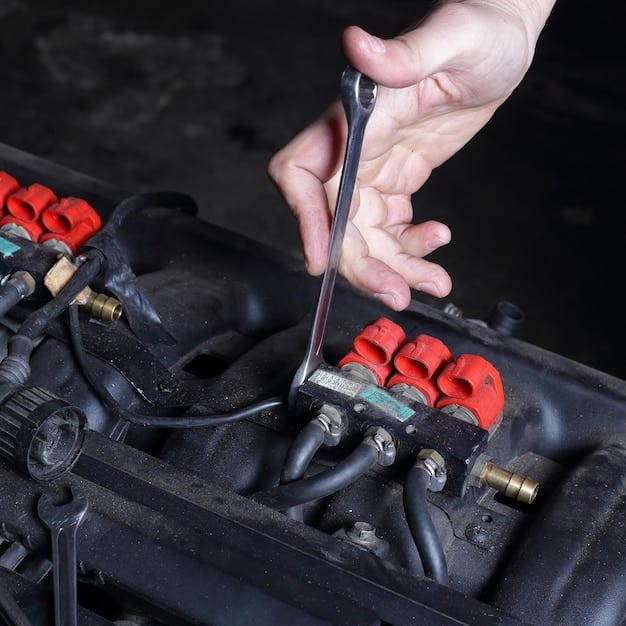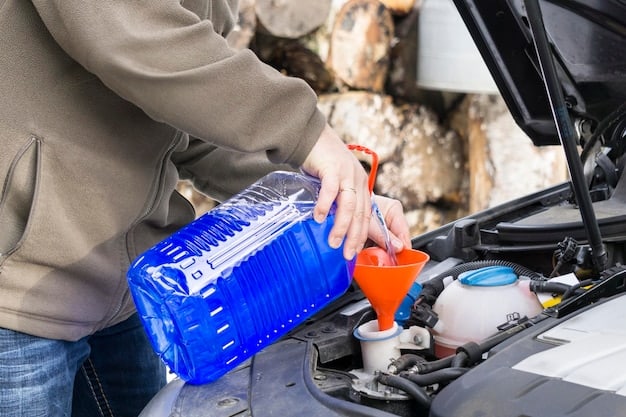Extend Your Car Battery Life by 2 Years: DIY Guide

Extend your car battery life by 2 years through simple DIY maintenance. This guide provides actionable steps to clean terminals, check water levels, and perform regular voltage tests, ensuring a longer and more reliable battery lifespan, saving you time and money.
Your car battery is the unsung hero that gets you going every day. But did you know that with a little DIY love, you can extend your car battery life by 2 years or even more? This isn’t just about saving money; it’s about avoiding the frustration of a dead battery on a cold morning or during an important trip.
This guide will walk you through a step-by-step maintenance routine that anyone can follow. We’ll cover everything from simple cleaning to more advanced checks, ensuring your battery remains in top condition. Are you ready to get started and ensure your car battery goes the distance?
Understanding Your Car Battery
Before diving into the maintenance steps, it’s important to understand what your car battery does and what factors can affect its lifespan. Your car battery provides the initial jolt needed to start your engine, powers electrical components when the engine is off, and stabilizes voltage to protect the car’s electronics.
Common Causes of Battery Failure
Several factors can lead to premature battery failure. Understanding these can help you take preventative measures:
- Extreme Temperatures: Both heat and cold can damage a battery. Heat can cause the battery fluid to evaporate, while cold reduces the battery’s ability to hold a charge.
- Short Trips: Frequent short trips don’t give the alternator enough time to fully recharge the battery.
- Parasitic Drain: Leaving lights on or having faulty electronics can drain the battery even when the car is off.
- Corrosion: Corrosion on the terminals can impede the flow of electricity.
Proper maintenance, as outlined in this extend your car battery life by 2 years guide, can mitigate these issues and significantly prolong your battery’s life.

Types of Car Batteries
Knowing the type of battery in your car can help you understand its specific maintenance needs. Common types include:
- Lead-Acid Batteries: The most common type, these batteries are reliable and relatively inexpensive.
- AGM (Absorbent Glass Mat) Batteries: These are spill-proof and offer better performance in extreme temperatures.
- Lithium-Ion Batteries: Found in some newer vehicles, these batteries are lighter and more efficient but more expensive.
Understanding the type of battery you have will enable you to tailor your maintenance routine accordingly, ensuring you can extend your car battery life by 2 years as effectively as possible.
In conclusion, understanding the basics of your car battery is crucial for effective maintenance. By knowing the common causes of failure and the type of battery you have, you can better protect your investment and ensure a longer lifespan.
Step-by-Step Guide to Cleaning Battery Terminals
One of the simplest and most effective ways to extend your car battery life by 2 years is to regularly clean the battery terminals. Corrosion buildup can impede the flow of electricity, leading to starting problems and reduced battery performance.
Gather Your Supplies
Before you start, gather the necessary supplies:
- Wrench: To disconnect the battery cables.
- Baking Soda: To neutralize acid buildup.
- Water: To create a cleaning solution.
- Wire Brush or Terminal Cleaner: To scrub away corrosion.
- Protective Gloves: To protect your hands.
- Safety Glasses: To protect your eyes.
The Cleaning Process
Follow these steps to safely and effectively clean your battery terminals:
- Disconnect the Battery: Use a wrench to disconnect the negative (-) terminal first, followed by the positive (+) terminal. This prevents accidental short circuits.
- Prepare the Cleaning Solution: Mix one tablespoon of baking soda with one cup of water.
- Apply the Solution: Dip the wire brush or terminal cleaner into the solution and scrub the terminals and cable clamps thoroughly.
- Rinse and Dry: Rinse the terminals and clamps with clean water and dry them with a cloth.
- Reassemble: Reconnect the positive (+) terminal first, followed by the negative (-) terminal. Ensure the connections are tight.
Regular cleaning, as part of a maintenance routine, can significantly contribute to your goal to extend your car battery life by 2 years. Aim to clean the terminals every three to six months, or more frequently if you live in a corrosive environment.
Safety First
Always prioritize safety when working with car batteries. Wear protective gloves and safety glasses to prevent chemical burns or eye damage. Ensure the area is well-ventilated, and never smoke or use open flames near the battery.
In conclusion, cleaning your battery terminals is a straightforward yet crucial step in maintaining your car battery’s health. By following these steps and prioritizing safety, you can prevent corrosion buildup and significantly extend the lifespan of your battery, helping you to extend your car battery life by 2 years.
Checking Battery Water Levels
For some types of car batteries, particularly traditional lead-acid batteries, checking and maintaining the water levels is crucial to extend your car battery life by 2 years. The electrolyte solution, a mixture of sulfuric acid and water, needs to be at the correct level for the battery to function properly.
Maintaining proper electrolyte levels in your car battery is crucial for its health and longevity. Ensuring the correct level helps the battery to function optimally and prevent damage, crucial to extend your car battery life by 2 years.
Safety Precautions
Before you begin, take the following safety precautions:
- Wear Protective Gear: Always wear gloves and safety glasses to protect against acid splashes.
- Work in a Ventilated Area: Ensure proper ventilation to avoid inhaling harmful fumes.
- No Open Flames: Never use open flames or smoke near the battery.
Checking the Water Levels
Follow these steps to check and replenish the water levels:
- Locate the Battery Cells: Most lead-acid batteries have removable caps on top that provide access to each cell.
- Inspect the Electrolyte Level: Look inside each cell. The electrolyte should cover the plates. If the plates are exposed, the water level is too low.
- Add Distilled Water: Use a funnel to carefully add distilled water to each cell until the plates are covered. Do not overfill.
- Replace the Caps: Securely replace the caps on each cell.

Why Distilled Water?
It is crucial to use distilled water rather than tap water. Tap water contains minerals and impurities that can react with the battery acid, reducing its effectiveness and potentially damaging the battery.
In conclusion, checking and maintaining the water levels in your car battery is a simple yet vital task for extend your car battery life by 2 years. By taking these precautions and following the steps outlined above, you can ensure your battery remains in optimal condition and lasts longer.
Performing Regular Voltage Tests
Regularly testing the voltage of your car battery is an excellent way to monitor its health and anticipate potential issues before they lead to a breakdown. Consistent voltage checks are crucial in your quest to extend your car battery life by 2 years. A healthy battery should maintain a voltage within a specific range, indicating its ability to hold and deliver a charge effectively.
What You’ll Need
To perform a voltage test, you will need:
- Multimeter: A digital multimeter is recommended for accurate readings.
- Safety Glasses: To protect your eyes.
- Gloves: To protect your hands.
Testing Procedure
Follow these steps to test your car battery’s voltage:
- Prepare the Multimeter: Set the multimeter to measure DC voltage, typically in the 20V range.
- Connect the Probes: Connect the red probe to the positive (+) terminal of the battery and the black probe to the negative (-) terminal.
- Read the Voltage: Observe the voltage reading on the multimeter display.
- Record the Results: Note the voltage reading for future comparison.
Interpreting the Results
Here’s what the voltage readings typically indicate:
- 12.6V or Higher: The battery is fully charged and in good condition.
- 12.4V to 12.6V: The battery is partially charged and may need a recharge.
- 12.2V or Lower: The battery is significantly discharged and needs immediate attention.
Regular voltage testing, when combined with other maintenance tasks, as discussed in this extend your car battery life by 2 years guide, forms a complete strategy for ensuring your car battery’s health and longevity.
In conclusion, performing regular voltage tests is an essential part of car battery maintenance. By following these steps and interpreting the results correctly, you can proactively address any issues and extend your car battery life by 2 years.
Preventative Measures for Longer Battery Life
Beyond regular maintenance, adopting certain preventative measures can significantly extend your car battery life by 2 years. These measures involve adjusting your driving habits and making small changes to how you use your vehicle’s electrical systems.
Minimize Short Trips
Short trips can be particularly harsh on your battery because the alternator may not have enough time to fully recharge it after starting the engine. Try to combine errands or take longer routes occasionally to ensure the battery gets a full charge cycle.
Turn Off Accessories
Before turning off your car, make sure all accessories, such as headlights, interior lights, and the radio, are turned off. This prevents unnecessary drain on the battery when the engine is not running.
Limit Electrical Usage When Idling
Avoid using power-hungry accessories like air conditioning or the radio for extended periods when the engine is idling. The alternator may not be able to supply enough power to both run the accessories and recharge the battery simultaneously.
Battery Storage Tips
If you plan to store your car for an extended period, consider using a battery tender or trickle charger to maintain the battery’s charge. Alternatively, you can disconnect the battery cables to prevent parasitic drain.
Regularly Inspect Battery Components
Keep an eye on the overall condition of your car battery and its components. Look for signs of damage, such as cracks or leaks, and address them promptly. Ensure that the battery is securely mounted to prevent vibrations that can damage internal components.
By implementing these preventative measures, you’re taking additional steps to extend your car battery life by 2 years, ensuring it remains reliable and efficient.
In conclusion, preventative measures are a vital component of a comprehensive battery maintenance strategy. By minimizing stress on your battery and addressing potential issues proactively, you can significantly increase its lifespan and reliability to extend your car battery life by 2 years.
| Key Point | Brief Description |
|---|---|
| 🔋 Terminal Cleaning | Clean terminals to prevent corrosion. |
| 💧 Water Levels | Check and maintain water levels (lead-acid). |
| ⚡ Voltage Tests | Regular tests to monitor battery health. |
| 🚫 Short Trips | Minimize for optimal charging. |
Frequently Asked Questions
It’s recommended to clean your car battery terminals every three to six months. However, if you live in an area with high corrosion or extreme weather, you might want to clean them more frequently to ensure optimal performance.
Always use distilled water when refilling your car battery. Tap water contains minerals that can harm the battery and shorten its lifespan. Distilled water is pure and won’t cause any adverse reactions.
You can use a multimeter to check your car battery voltage. Connect the red probe to the positive (+) terminal and the black probe to the negative (-) terminal. A reading of 12.6V or higher indicates a fully charged battery.
Common warning signs include slow engine cranking, dimming headlights, and the battery warning light illuminating on your dashboard. If you notice any of these signs, it’s a good idea to have your battery tested.
Yes, short trips can prevent your car’s alternator from fully recharging the battery, leading to a gradual discharge. Whenever possible, try to combine your short trips into a longer drive to give the battery a chance to recharge fully.
Conclusion
By following this step-by-step DIY maintenance guide, you can significantly extend your car battery life by 2 years or even more. Regular cleaning, proper water level maintenance, and voltage testing, combined with preventative measures, will keep your battery in optimal condition, ensuring reliable starts and saving you money in the long run.
Don’t wait until you’re stranded with a dead battery, take proactive steps and enjoy the peace of mind that comes with a well-maintained car battery!





